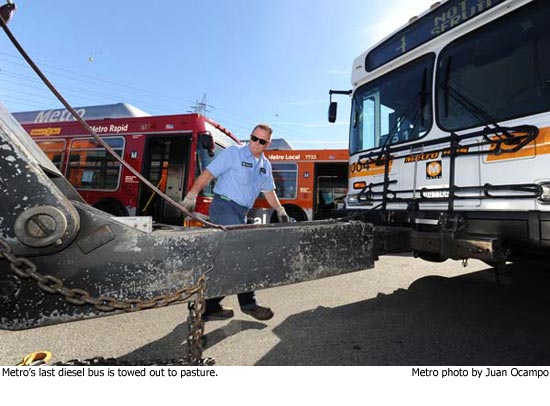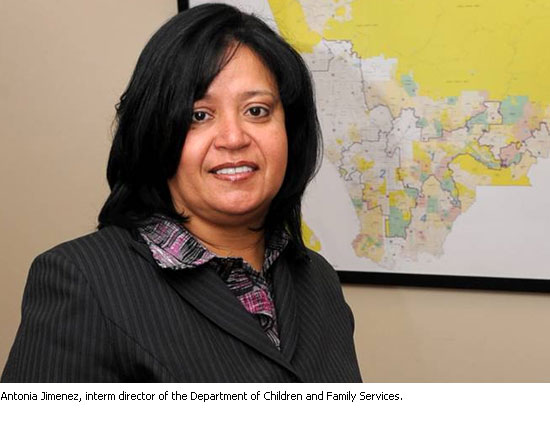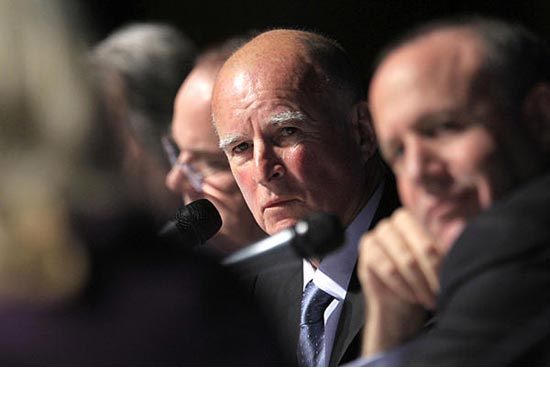Shed no tears for the last diesel bus
January 13, 2011
As Metro retired the last of its smog-belching diesel buses this week, the agency marked the occasion with all the hoopla befitting the end of an era. There was a press conference highlighting Metro’s now 100% clean-burning bus fleet, and an unceremonious towing-away of the last diesel dinosaur.
At the same time, the agency’s library took a moment to look back at a very different Los Angeles, when the first diesel buses made their appearance here in 1940.
At the time, the coming of those initial 72 buses was hailed as a breakthrough in speed and comfort.
“These coaches offer a new degree of smooth acceleration with no vibration or uneven motion,” according to a trade publication quoted in the library account. “Attractive interiors boast mohair upholstered seats, stainless steel fittings, spacious aisles and wide windows.”
But things were about to get a lot more uncomfortable for the breathing public in the City of Angels. And vehicle exhaust—from cars and those ballyhooed buses—eventually would prove to be a major culprit.
“The dawn of diesel didn’t bode well for Los Angeles,” the library’s article said. “Just a couple of years later, Angelenos began noticing something else around town besides their new fleet of buses with mohair upholstery. On July 26, 1943, L.A. suffered through its first day of ‘smog.’ ”
The article includes this link to historic photos from the UCLA Library documenting some of the worst moments of the smog era in Los Angeles.
With the departure of the last diesel bus, Metro becomes the only major U.S. transit agency with a bus fleet made up entirely of clean-burning alternative-fuel vehicles.
As recently as 1984, the agency’s fleet had included more than 3,300 diesel buses. Its transition away from diesel started in 1993, when Metro’s Board of Directors decided to start buying only alternative fuel clean air buses.
Today, the agency has 2,221 compressed natural gas buses, six gasoline-electric hybrids and one electric bus. The switch to natural gas has meant a drop in greenhouse gas emissions of nearly 300,000 pounds a day, compared to what would be emitted by diesel buses, the agency said.
Metro’s blog The Source, meanwhile, has the lowdown on the fate that awaits Old Number 3004.

Posted 1/13/11
She’s got the toughest temp job in town
January 12, 2011
 Three months ago, Antonia Jimenez was the new kid on the block in Los Angeles County’s Chief Executive Office.
Three months ago, Antonia Jimenez was the new kid on the block in Los Angeles County’s Chief Executive Office.
Today, she’s at the helm of one of the county’s most challenged departments, one with a mission second to none: saving kids’ lives.
As the newly appointed interim director of the Department of Children and Family Services, Jimenez has been thrust into a job in which leadership decisions can have enormous real life consequences, with every wrong move getting a very public airing.
Jimenez is just two weeks into the job but already is confronting longstanding trouble spots and dishing out straight talk about what’s wrong—and right—with the department she’s been charged with running since the reassignment of former director Trish Ploehn.
“You have great, great social workers,” Jimenez said in her first in-depth interview since taking the interim director’s job. “I don’t think there’s a lack of talent there. But within that are the mediocre ones who never should have been social workers in the first place.”
Such “problem workers” figured into a review of the department that Jimenez oversaw before assuming her new post. That analysis, released in November, also found: significant backlogs in cases requiring emergency responses; time-consuming and often unfocused mandatory training sessions for administrators, and a welter of “duplicative or contradictory” policies that make it harder for social workers to do their jobs effectively.
Jimenez—who says she’s not permanently pursuing the top job—is realistic about what she can fix as an interim director.
“I’m very honest with the staff. Kids will die, unfortunately…But no kid should die because we haven’t done our job,” she says.
Jimenez, 49, was born in Puerto Rico, grew up in Manhattan and had a two-decade career in Massachusetts state government and several years in the private sector before county CEO William T Fujioka hired her in September as a $215,000-a-year deputy CEO.
As the deputy coordinating and overseeing issues involving children and families, Jimenez didn’t have the luxury of slowly breaking in. She found herself on the front lines of the internal turmoil and public outrage stemming from a series of highly publicized deaths of children who’d had earlier contact with DCFS.
Now that she’s on the inside, she recognizes even more the urgency of getting up to speed.
“You always have a learning curve,” she says. “I have done this little listening tour, and I need to do more.” Doing more includes additional ride-alongs with social workers and observing department hotline and command post operations up close.
One of her top priorities, she says, is to tackle a backlog of emergency cases that have not received action for more than 30 or even 60 days, despite the potential dangers this poses to children. She plans to increase staffing in the seven regional offices with the highest backlogs—particularly in three that account for 50% of the overall total. Jimenez says she’s not only reassigning and transferring employees, but also bringing in “experienced temps” for 120 days “to really focus on this problem.”
In the next few weeks, she’ll also be focusing on the hotline, the first point of contact with the department when a child’s safety is at risk.
She says she will examine staffing levels and the experience of hotline employees, with the aim of making sure that calls that need prompt attention get it and are not placed behind those that can wait a little longer. The goal: “We deal with ‘immediate’ immediately.”
Jimenez, who’s living in Redondo Beach with a friend until she can find the time to get her own place, understands that someone in such a sensitive position must take strong action and cannot simply be a caretaker until a permanent replacement is found. (Read Zev’s blog on what he believes the department needs in a new leader.)
Jimenez acknowledges that the upheaval in the department, culminating with Ploehn’s departure, has been tough on the staff. But it’s also been difficult for her, she says.
“I didn’t come to Los Angeles to remove a director. That wasn’t my job,” she says. “The transition for them, the transition for me, was also hard.”
Posted 1/12/11
High art, low price
January 12, 2011
Brazilian dancers at the Music Center? Shepard Fairey deejaying after parties? Seminars for Westside photo connoisseurs?
If it’s January, then it must be Los Angeles Arts Month. And if you weren’t downtown last Wednesday for the lunch hour kickoff with Cirque du Soleil and the guys from Los Lobos, then there’s still plenty of culture to catch at once-a-year bargain prices.
Museum shops are offering discount coupons. The Pasadena Playhouse has orchestra seats for half-price. Tickets to upcoming performances of “The Turn of the Screw” are two-for-the-price-of-one at the Los Angeles Opera. And you can catch the Los Angeles Philharmonic for 20% off for selected concerts. Plus, admission to both Gettys, The Hammer and about a dozen other big museums will be free during the last weekend of the month.
Now in its third year, L.A. Arts Month was launched by city government and arts groups to promote local art and culture. It has since expanded to encourage patronage of the arts countywide.
“This is a way for families to get out and see what L.A. has to offer,” says Allison Starcher, taking a momentary break from her job as show manager for the 16th annual Los Angeles Art Show, an anchor event from January 19-23 that is expected to draw some 40,000 visitors to the Los Angeles Convention Center. “L.A. has amazing museums, incredible theaters and wonderful galleries. There are very few cities where you can experience so much.”
The L.A. Art Show will, as always, run the gamut, opening with a gala benefit and that exclusive after-party hosted by Fairey, with free admission for kids under 17. The show will boast rare images by Henri Cartier Bresson, first-time exhibitions from galleries in China, a Sunday conversation with the punk graphic artist Robert Williams, and installations by street muralists Vox Humana, not to mention tours of the public art in L.A.’s own Metro stations.
Also in town this month will be the 20th annual International Los Angeles Photographic Art Exposition, the Brazilian dance troupe Grupo Corpo, a Films 4 Change documentary and food tasting at the Broad Stage, and a vast array of ongoing exhibitions and shows.
And that’s not even counting the buildup to the much-anticipated “Pacific Standard Time” exhibition—years in the making—about L.A.’s role in the post-World War II art world. Culture fans will have to wait until October for that one, but it’s already a looming presence. Massive and region-wide, it’s planned as a sort of collaborative blitz of art shows on a single subject, spanning Southern California and involving more than 50 art institutions.
Posted 1/12/11
Brown’s budget painful but “real”
January 11, 2011
Crunching the numbers in Gov. Jerry Brown’s proposed budget, Los Angeles County officials are bracing for deep cuts in services and potentially many millions of dollars in less visible costs.
An executive summary of the potential impacts shows that a $1.5 billion statewide cut in the CalWorks welfare program could trim the program by $450 million in Los Angeles County, spelling the loss of benefits for some 37,000 families here. That, in turn, could create new demands on the county’s general relief program, leading to additional costs in an already strained county budget.
Meanwhile, the county Department of Health Services stands to lose some $20 million if a proposed $1.7 billion in cuts, including reductions in payments to providers, are made to the state’s Medi-Cal program. Those cuts would pose challenges for the county’s perennially deficit-plagued health department budget and contribute to “some serious problems in our provision of health care here in L.A. County,” Chief Executive Officer William T Fujioka told supervisors on Tuesday.
The executive summary of potential budget impacts also outlined what’s coming the county’s way under “realignment,” in which responsibility for many programs would shift from the state to the local level.
For one thing, the county’s Probation Department would assume responsibility for 30,000 or more “violent and serious” state parolees, including sexual predators, at an additional cost of $185.3 million—excluding the cost of hiring new staff and related expenses, Fujioka said. County jails also would absorb 13,550 convicted felons now in state custody—nonviolent offenders without sex crimes convictions—at a potential cost of more than $450 million. Other passed-along expenses would come in areas ranging from child welfare and foster care ($557 million) to court security ($132.5 million.)
“What is of serious concern…is whether or not we have sufficient funding to maintain the current level of services that will be sent from the state,” Fujioka told supervisors. “If these services come to us without the necessary revenue, it puts a burden on our already… severely challenged programs and services.”
His remarks echoed comments by Supervisors Zev Yaroslavsky and Gloria Molina, whose Op-Ed piece this week in the Los Angeles Times argued for a “financially sustainable” proposal that would allow local governments to help the state through its crisis.
Yaroslavsky was attending a funeral Tuesday morning and did not attend the board meeting. Molina used the occasion to forcefully call on county officials to enter into a true partnership with the state and find constructive ways to achieve the inevitable cuts.
“If you aren’t part of the solution then get the hell out of the way,” Molina said. “Nobody’s going to listen to a bunch of moaners and whiners and we in L.A. County shouldn’t do that.”
“Crying crocodile tears,” she said, “is not going to impress them [in Sacramento].”
The governor’s budget hinges on voter approval of a proposed June ballot initiative that would extend a 1% sales tax and a .5% vehicle license fee for five years in order to fund the programs that would become county responsibilities under realignment. At the end of five years, the state would pick up the funding responsibility, according to the county’s budget impact report.
But Fujioka told supervisors that passage of the ballot initiatives is far from assured. “Extending the taxes and fees is not a given…That is going to be a very difficult request to get through the state Legislature and also through the electorate.”
Supervisor Michael D. Antonovich criticized the governor, arguing that the proposed budget dodged the necessity of reforming state spending patterns.
“There are dollars that are being generated but they’re not being allocated to appropriate areas,” he said. “And then to get rid of their irresponsibilities by shifting it to the cities and counties without any stable source of long term funding makes no sense.”
“I was expecting the governor to be bold in addressing these issues,” Antonovich said, “instead of basically doing what Arnold Schwarzenegger had done.”
But Molina praised the governor for getting the budget out early and for letting the county—along with all Californians—know how much pain is in store as the state seeks to climb out of a profound economic “ditch.”
“The governor has put it squarely in front of us,” Molina said. “Here’s the numbers. Like ‘em or not, they’re real.”
Posted 1/11/11
A time to cool the rhetoric
January 10, 2011

On Saturday morning, before she was shot, Gabrielle Giffords was performing one of her most vital duties as a public servant. She was meeting with the public.
The Arizona congresswoman knew there were risks; last March, the windows of her office were shattered after her vote for health care reform. During her hotly contested campaign for reelection, gun gimmicks and imagery abounded.
On a map on Sarah Palin’s political action committee’s website, Giffords’ district was among a number that had been depicted with cross hairs. Her election opponent, meanwhile, held a campaign event in which participants were offered the opportunity to fire a fully loaded M-16 with him, a symbol of his assault on Giffords’ seat.
But none of this deterred Giffords from convening another of her “Congress on Your Corner” events. For she, like virtually every public official, understands the imperative of direct interaction with constituents.
During my 35 years in elected office in Los Angeles, I’ve been to hundreds of neighborhood meetings and town halls. Only when I’m in the community can I hear—and feel—the aspirations and frustrations of my constituents. Without this kind of relationship, I’d be left with middlemen of pundits and pollsters to help me gauge the public pulse—a very poor substitute for face-to-face encounters.
I feel certain that this weekend’s horrific shooting spree will not deter most public officials from meeting with large, sometimes unruly gatherings of constituents. Indeed, should our leaders become reluctant or fearful to engage the public they represent, our political system itself would be put at risk.
To be sure, it’s clear from all accounts that Giffords’ alleged assailant, who killed 6 people in a matter of seconds, was disturbed long before the bloodshed. He was rejected for military service, and he was expelled from community college for his bizarre behaviors. His disjointed and paranoid screeds against the government speak for themselves. (The fact that he was able to easily and legally buy an automatic handgun is a topic for another day soon.)
But I also believe that troubled individuals teetering on the edge of mayhem can be pushed into action by incendiary language mostly intended to win elections or amass TV ratings, words that create a climate of hostility, aggression and violence.
Congresswoman Giffords, who remains in critical condition, may have put it best last spring when she was asked about her district being targeted with cross hairs on Palin’s election map.
“When people do that,” Giffords said, “they’ve got to realize there’s consequences to that.”
For the time being, I’d suggest that politicians and media personalities, who exploit public fears and advance their careers through the use of vitriol, ratchet down the rhetoric and discipline themselves as we all reflect on the events that led to this national tragedy.
Posted 1/10/11
A man, a chair, a few pages—theater!
January 6, 2011
 He swore he’d never do another solo show after the last one flopped off-Broadway nearly 30 years ago, but you can’t keep a good actor down. This week, John Lithgow returns to the form he once left behind with a new production, Stories By Heart, in which the star of stage, screen and television performs a pair of stories cherished from his childhood by authors P.G. Wodehouse and Ring Lardner. It’s just John, his chair, a few pages—and more than 40 years of acting craft from a modern master. The show runs at the Music Center’s Mark Taper Forum through February 13, 2011. Buy your tickets online here. And here’s a visitors’ guide.
He swore he’d never do another solo show after the last one flopped off-Broadway nearly 30 years ago, but you can’t keep a good actor down. This week, John Lithgow returns to the form he once left behind with a new production, Stories By Heart, in which the star of stage, screen and television performs a pair of stories cherished from his childhood by authors P.G. Wodehouse and Ring Lardner. It’s just John, his chair, a few pages—and more than 40 years of acting craft from a modern master. The show runs at the Music Center’s Mark Taper Forum through February 13, 2011. Buy your tickets online here. And here’s a visitors’ guide.
Posted 1/6/11
Counting on each other
January 6, 2011

Happy New Year to you all. Together, let’s start 2011 on the right foot—literally. Please join my staff and me for the bi-annual Homeless Count. The Los Angeles Homeless Services Authority needs 4,000 volunteers to hit the streets between January 25-27.
As you’ll see from this story on my website, the count is required for federal homeless funds to flow to counties and cities across the nation. Never before has there been a more determined commitment in the public and private sectors to end chronic homelessness by providing those in need with permanent housing and services.
Last month, the United Way of Greater Los Angeles and the Los Angeles Area Chamber of Commerce released a blueprint—called Home for Good—with the ambitious but achievable goal of ending chronic homelessness in five years.
And just this week, we were able to allocate nearly $1.7 million in Third District homeless funds to two organizations in the forefront of the growing movement to provide permanent supportive housing—Step up on Second and OPCC. For more details, read here.
So, I hope I can count on you to join this year’s Homeless Count and make a tangible difference in someone’s life.
Another kind of true grit at LACMA
January 6, 2011
The Los Angeles County Museum of Art kicks off the new year right with a special film series, True Grit: The Golden Age of Road Movies, running January 7-21. The program explores a unique time and place in recent American history, when the rootlessness, alienation and disaffection of the late 1960s found expression through an American film industry suffering the partial collapse of the traditional studio system and the rise of irreverent independent productions. Featured will be such classics of the era as “Bonnie and Clyde,” “Easy Rider, and “Two-Lane Blacktop.” And be sure to check out the accompanying photographic exhibit, William Eggleston: Democratic Camera, showcasing an artist considered both “a master of color photography” and “a poet of the mundane.” Tickets are online here. You can plan your visit here, with full information on hours, parking, directions, disability access and dining options.
Posted 1/6/11
New year, new nature hikes
January 6, 2011
 Safety razor magnate King Gillette built his dream home in Calabasas in the late 1920s, but died nearly penniless—a victim of age, infirmity and the Great Depression—before he ever got the chance to move in. After changing hands several times through the decades, the King Gillette ranch was finally acquired for the California State Parks system.
Safety razor magnate King Gillette built his dream home in Calabasas in the late 1920s, but died nearly penniless—a victim of age, infirmity and the Great Depression—before he ever got the chance to move in. After changing hands several times through the decades, the King Gillette ranch was finally acquired for the California State Parks system.
Today the ranch, once owned by entertainer Bob Hope, is one of the crown jewels of the Santa Monica Mountains, its 588 acres offering unparalleled scenic views and hiking experiences. And this month affords visitors several opportunities to get acquainted with this very special place.
On Sunday, January 9, bird-watchers can enjoy a special “Birds of Winter” program, observing some of the many bird species that visit the Santa Monicas at this time of year. Convene at the native plant garden at 8 a.m. for the 2½ hour program, which includes an accessible one-mile walk. And on Saturday, January 22, shutterbugs are welcome as a professional nature photographer offers tips and advice on how to perfectly capture that precious moment in time. Meet at the native plant garden at 2 p.m. Information on both programs is here.
Here is some more King Gillette Ranch background and directions; for additional program information, call (818) 878-0866 x228. The programs are free, but don’t forget the $7 parking fee. And please note these hiking and safety tips.
Posted 1/6/11













 Check for the latest closure information
Check for the latest closure information








